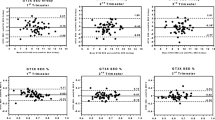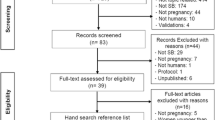Abstract
Objectives To quantify and compare the sedentary time estimated by the Sedentary Behavior Questionnaire (SBQ) and the sedentary time objectively measured by a multi-sensor monitor (SWA) in pregnant women. Methods One hundred eighty-six participants answered the SBQ and wore the SWA at least 7 valid days. The concordance, correlation, agreement and relative activity levels between both measures of sedentary time were examined. Differences of sedentary time between weekday and weekend and between groups stratified by sociodemographic and clinical characteristic were evaluated by one-way analysis of variance. Results Pregnant women were sedentary the 64% of their waking hours. Television viewing is the most prevalent sedentary behavior. The concordance, correlation, and agreement between SBQ and SWA were weak, yet a significant correlation in weekday and average day sedentary time (r = 0.23 and 0.20, P = 0.001 and 0.008, respectively) was observed. A significant linear trend was found for increasing sedentary time between both methods using a relative activity levels analysis. Conclusions for Practice Pregnant women experience high amount of sedentary time, for approximately half of the day. The SBQ shows a low validity and agreement, but strong ability to rank individuals compared with SWA in pregnant women.
Similar content being viewed by others
References
Blair, S. N. (2009). Physical inactivity: The biggest public health problem of the 21st century. British Journal of Sports Medicine, 43, 1–2.
Bland, J. M., & Altman, D. G. (1986). Statistical methods for assessing agreement between two methods of clinical measurement. The Lancet, 327(8476), 307–310.
Bond, D. S., Thomas, J. G., Unick, J. L., et al. (2013). Self-reported and objectively measured sedentary behavior in bariatric surgery candidates. Surgery for Obesity and Related Diseases, 9(1), 123–128.
Both, M. I., Overvest, M. A., Wildhagen, M. F., et al. (2010). The association of daily physical activity and birth outcome: A population-based cohort study. European Journal of Epidemiology, 25(6), 421–429.
Busschaert, C., De Bourdeaudhuij, I., Van Holle, V., et al. (2015). Reliability and validity of three questionnaires measuring context-specific sedentary behaviour and associated correlates in adolescents, adults and older adults. The International Journal of Behavioral Nutrition and Physical Activity, 12(1), 117.
Di Fabio, D. R., Blomme, C. K., Smith, K. M., et al. (2015). Adherence to physical activity guidelines in mid-pregnancy does not reduce sedentary time: An observational study. The International Journal of Behavioral Nutrition and Physical Activity, 12(1), 191.
Evenson, K. R., & Wen, F. (2011). Prevalence and correlates of objectively measured physical activity and sedentary behavior among US pregnant women. Preventive Medicine, 53(1–2), 39–43.
Ferrari, P., Friedenreich, C., & Matthews, C. E. (2007). The role of measurement error in estimating levels of physical activity. American Journal of Epidemiology, 166(7), 832–840.
Gradmark, A., Pomeroy, J., Renstrom, F., et al. (2011). Physical activity, sedentary behaviors, and estimated insulin sensitivity and secretion in pregnant and non-pregnant women. BMC Pregnancy and Childbirth, 11, 44.
Hamilton, M. T., Healy, G. N., Dunstan, D. W., et al. (2008). Too little exercise and too much sitting: Inactivity physiology and the need for new recommendations on sedentary behavior. Current Cardiovascular Risk Reports, 2(4), 292–298.
Hawkins, M., Pekow, P., & Chasan-Taber, L. (2014). Physical activity, sedentary behavior, and C-reactive protein in pregnancy. Medicine and Science in Sports and Exercise, 46(2), 284–292.
Jiang, H., Qian, X., Li, M., et al. (2012). Can physical activity reduce excessive gestational weight gain? Findings from a Chinese urban pregnant women cohort study. The International Journal of Behavioral Nutrition and Physical Activity, 9, 12.
Lin, L. (1989). A concordance correlation coefficient to evaluate reproducibility. Biometrics, 45(1), 255–268.
Lohman, T. G., Roche, A. F., & Martorell, R. (1988). Anthropometric standardization reference manual. Human Kinetics Books, 177, 3–8.
Loprinzi, P. D., Fitzgerald, E. M., Woekel, E., et al. (2013). Association of physical activity and sedentary behavior with biological markers among U.S. pregnant women. Journal of Women’s Health (2002), 22(11), 953–958.
Matthews, C. E., Chen, K. Y., Freedson, P. S., et al. (2008). Amount of time spent in sedentary behaviors in the United States, 2003–2004. American Journal of Epidemiology, 167(7), 875–881.
Munguía-Izquierdo, D., Segura-Jiménez, V., Camiletti-Moirón, D., et al. (2013). Spanish adaptation and psychometric properties of the sedentary behaviour questionnaire for fibromyalgia patients: The al-Andalus study. Clinical and Experimental Rheumatology, 31(Suppl.79), S22–S33.
Oken, E., Ning, Y., Rifas-Shiman, S. L., et al. (2006). Associations of physical activity and inactivity before and during pregnancy with glucose tolerance. Obstetrics and Gynecology, 108(5), 1200–1207.
Owen, N., Healy, G. N., Matthews, C. E., et al. (2010). Too much sitting: The population-health science of sedentary behavior. Exercise and Sports Sciences Reviews, 38(3), 105–113.
Padmapriya, N., Shen, L., Soh, S. E., et al. (2015). Physical activity and sedentary behavior patterns before and during pregnancy in a multi-ethnic sample of Asian women in Singapore. Maternal and Child Health Journal, 19(11), 2523–2535.
Pavey, T. G., Peeters, G. G., & Brown, W. J. (2015). Sitting-time and 9-year all-cause mortality in older women. British Journal of Sports Medicine, 49(2), 95–99.
Rosenberg, D. E., Norman, G. J., Wagner, N., et al. (2010). Reliability and validity of the Sedentary Behavior Questionnaire (SBQ) for adults. Journal of Physical Activity & Health, 7(6), 697–705.
Ruiz, J. R., Segura-Jiménez, V., Ortega, F. B., et al. (2013). Objectively measured sedentary time and physical activity in women with fibromyalgia: A cross-sectional study. BMJ Open, 3(6), 1–10.
Scholes, S., Coombs, N., Pedisic, Z., et al. (2014). Age- and sex-specific criterion validity of the health survey for England physical activity and sedentary behavior assessment questionnaire as compared with accelerometry. American Journal of Epidemiology, 179(12), 1493–1502.
Sedentary Behaviour Research Network. (2012). Letter to the Editor: Standardized use of the terms “sedentary” and “sedentary behaviours”. Applied Physiology, Nutrition, and Metabolism, 37(3), 540–542.
Seguin, R., Buchner, D. M., Liu, J., et al. (2014). Sedentary behavior and mortality in older women: The women’s health initiative. American Journal of Preventive Medicine, 46(2), 122–135.
Smith, K. M., Lanningham-Foster, L. M., Welk, G. J., et al. (2012). Validity of the SenseWear armband to predict energy expenditure in pregnant women. Medicine and Science in Sports and Exercise, 44(10), 2001–2008.
Terwee, C. B., Bot, S. D. M., de Boer, M. R., et al. (2007). Quality criteria were proposed for measurement properties of health status questionnaires. Journal of Clinical Epidemiology, 60(1), 34–42.
Thorp, A. A., Owen, N., Neuhaus, M., et al. (2011). Sedentary behaviors and subsequent health outcomes in adults: A systematic review of longitudinal studies, 1996–2011. American Journal of Preventive Medicine, 41(2), 207–215.
Tremblay, M. S., Colley, R. C., Saunders, T. J., et al. (2010). Physiological and health implications of a sedentary lifestyle. Applied Physiology, Nutrition, and Metabolism, 35(6), 725–740.
Tremblay, M. S., Esliger, D. W., Tremblay, A., et al. (2007). Incidental movement, lifestyle-embedded activity and sleep: New frontiers in physical activity assessment. Canadian Journal of Public Health, 98(Supp. 2), S208–S217.
U.S. Department of Labor. Bureau of Labor Statistics. (2016). American time use survey—2015 results. News Release, 16, 1–24.
Wijndaele, K., De Bourdeaudhuij, I., Godino, J. G., et al. (2014). Reliability and validity of a domain-specific last 7-d sedentary time questionnaire. Medicine and Science in Sports and Exercise, 46(6), 1248–1260.
Wood, L., Jago, R., Sebire, S. J., et al. (2015). Sedentary time among spouses: A cross-sectional study exploring associations in sedentary time and behaviour in parents of 5 and 6 year old children. BMC Research Notes, 8(1), 787.
Zhang, C., Solomon, C. G., Manson, J. E., et al. (2006). A prospective study of pregravid physical activity and sedentary behaviors in relation to the risk for gestational diabetes mellitus. Archives of Internal Medicine, 166(5), 543–548.
Acknowledgements
The study was funded by Research Group CTS-948 of University Pablo of Olavide. J.B. is supported by the Spanish Ministry of Education (grant number FPU13/05130). The authors gratefully acknowledge all women for their collaboration. We also acknowledge the health clinic members involved in the recruitment for their effort and great enthusiasm.
Author information
Authors and Affiliations
Corresponding author
Electronic supplementary material
Below is the link to the electronic supplementary material.
10995_2018_2473_MOESM1_ESM.tif
Supplemental Figure 1. Bland and Altman plots of the differences between SWA and SBQ for (a) week days, (b) weekend days, and (c) average day sedentary time. The means of the differences (solid lines) and limits of agreement (dashed lines) within ± 2 SDs are shown. Abbreviations: SWA (Sensewear) and SBQ (Sedentary Behaviors Questionnaire) (TIF 251 KB)
Rights and permissions
About this article
Cite this article
Oviedo-Caro, M.Á., Bueno-Antequera, J. & Munguía-Izquierdo, D. Measuring Sedentary Behavior During Pregnancy: Comparison Between Self-reported and Objective Measures. Matern Child Health J 22, 968–977 (2018). https://doi.org/10.1007/s10995-018-2473-6
Published:
Issue Date:
DOI: https://doi.org/10.1007/s10995-018-2473-6




